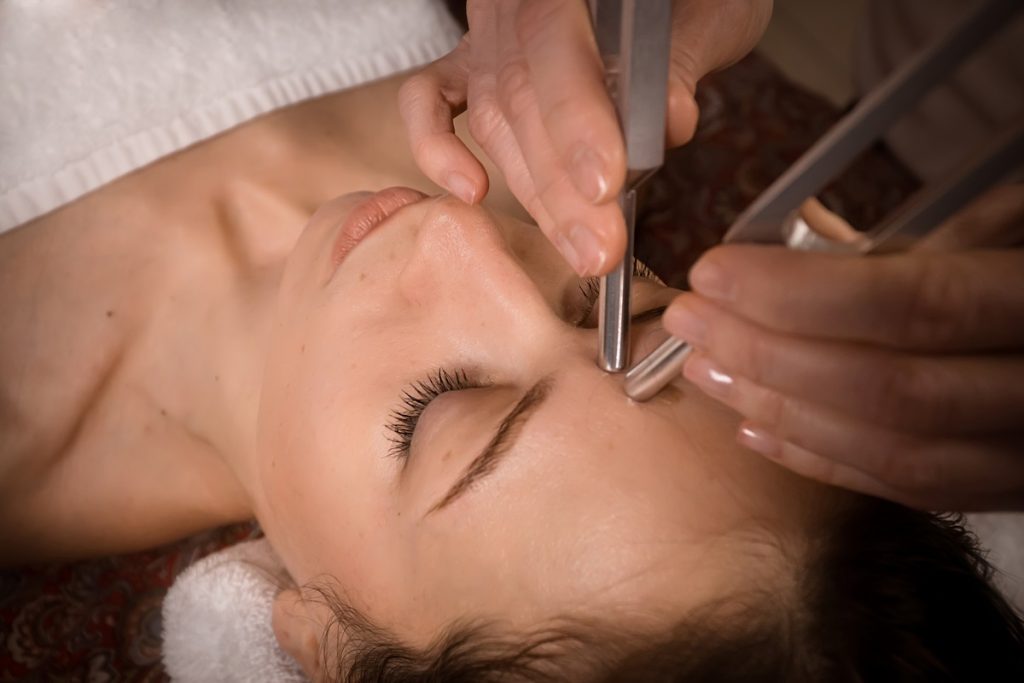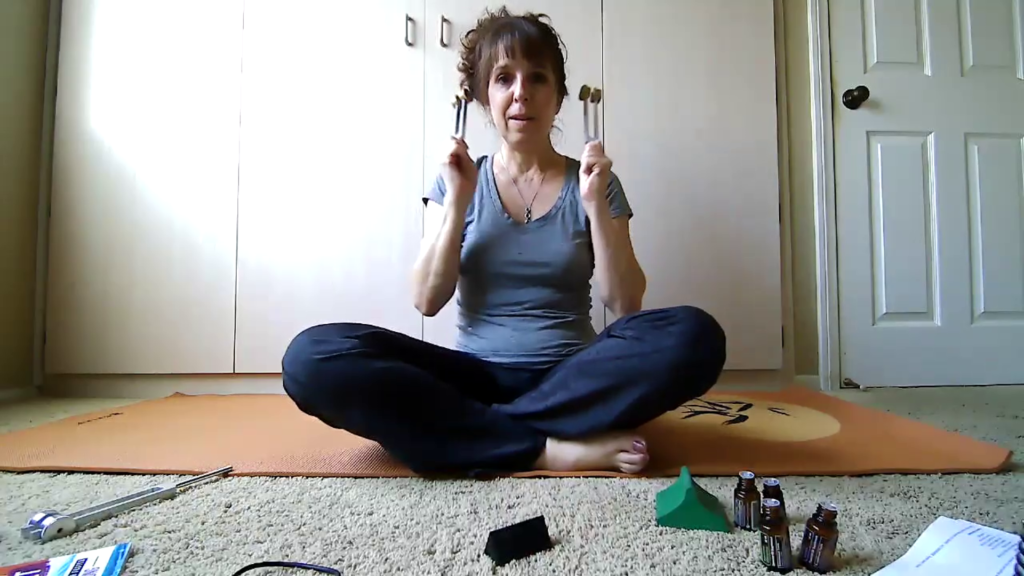Vibrational Sound Healing with Tuning Forks & Aromatherapy

AromaTune Tuning Forks Heal Body Mind Spirit!
- Restores, regenerates, and normalizes the somatic and autonomic nervous systems.
- Recalibrating and stimulating the Vegas nerve turning on the parasympathetic nervous system. Our “rest and digest” mode.
- Reducing “flight or fight” sympathetic tone.
- Healing the Body Mind & Spirit!
- *(Essential Oils are optional).
Powerfully treat body, brain, mind, head, and face conditions
Specialized Tuning Fork Acupuncture is Sound Healing from a tuning fork that creates vibrations you can hear and feel when placed on or above the body. Along with acupuncture needles sound induces a self-healing response, releases fluid build-up, congestion, benefits nerves, releases muscle tension, and improves circulation.
So that you can sleep, think clearly, feel energized, look and feel better about yourself from the inside out!
I like to call this treatment AromaTune. It is tuning fork aromatherapy acupuncture healing at its finest!

This treatment focus is for healing and improving potential for the body, spirit, mind, head, face, and brain.
- Memory
- Concentration, focus
- Insomnia
- Anxiety, fear, nervousness
- Mild depression
- Stressful feelings
- Feelings of overwhelm
- Chronic pain
- Muscular tension and trigger points
- The body’s holding patterns
- Sinus and nasal congestion, post-nasal drip, silent acid-reflux, mucus, phlegm, chronic cough, and clearing throat (not cough from CHF, COPD, or respiratory issue).
- TMJ and clenching teeth
- Bell’s Palsy
- Clarity, purpose, decisions, and passion in your life.
- Self-discovery
- Business and life passion.
You are worth it! Give your body what it needs to heal.
These specialty treatments are affordable, effective, and they feel wonderful!
The treatment is $75 for one-sided treatment about 30-45 minutes, or
$150 for full body front and back side about 45 minutes to 1-hour.
Ask about savings when you sign up for a treatment plan.
Payment is expected at time of service.
Insurance is not accepted for this service.
Stay in Tune with the Flow of Life!
Balance your meridian system and chakras; balances nerves, brain, and hormones.
(Chakras are your psycho-gland-nerve bundles found along your spine that are responsible for neurotransmitter release, and nerve transmission to glands, and organs.)
- To Feel strong, powerful, and joyful by finding clarity, purpose, and passion in your life.
- Self-discovery, business and life passion.
- Cancer support and calming the mind, nausea, fatigue,
- insomnia.
When in alignment your life will change dramatically!
Why Tuning Forks?
How does your brain, thoughts, and nervous system trigger pain and illness?
Noxious stimuli (bad pain, and stressors) cause nerve endings to release neurogenic inflammatory chemicals like substance P, NKA, CGRP, and more.
Noxious stimuli can be in the form of:
- Painful, hitting, slapping, pinching, kicking, hurling, strangling, shoving, or another similar stimulus.
- Any form of noxious, painful or intrusive spray or chemical inhalant
- Any form of disgusting tastes
- Electric shock
- A hot surface
- Water spray to the face
- Deep muscle squeezes.
- Sharp poke, or stab.
It induces a behavioral response to avoid the pain.
Constant negative thoughts and emotions are stored in our musculature, and connective tissue called fascia, creating tension, blocking circulation, which can lead to pain or disease.
The mind and negative thoughts are thought to be a behavioral response to avoid negative feelings.
These negative feelings stem from negative belief systems about ourselves.
The noxious stimuli and negative thoughts stimulate release of inflammatory chemicals as well as inducing a chronic “flight or fight” response in our sympathetic nervous system. These fluids are sticky!
Sticky Pressurized Fluid Buildup
These chemicals create a thick viscous fluid that stick to the muscle. Thus, muscles can stick together. Then we develop maladaptation, contraction, or weakness. Then trophic changes occur called adhesions.
- Adhesions we can feel as knots, nodules, tight bands, grainy crystal-like nodules, rubbery nodules, and areas of tenderness.
- Sticky fluid, and adhesions block flow of Qi-energy, blood and lymph. The flow is suboptimal thick, slow, or completely blocked. Oxygen, nutrient delivery, and waste removal are subpar.
- Noxious stimuli also increase sympathetic tone of the autonomic nervous system. This affects blood flow because it constricts and decreases oxygen transport to tissues.
Vibrational sound with tuning forks can be used to stop the neurogenic inflammation, unstick the tissue by cleaning the area, and release NO from cells.
Under healthy conditions, nerve endings, release water, proteins, and ions. Consistency is fluid like water. These are absorbed through muscle and pumped out.
How Can We Help You Feel Better?
We can provide a non-noxious stimulus that signals release of neurotransmitter’s that intercept nociception (pain) from ever reaching the brain.
- These good neurotransmitters are ones like dopamine, glutamate, and Gaba.
- The sound and pressure from the tuning fork help release pressurized sticky fluid in the tissues. This leads to pain reduction, and increased mobility.
Nitric Oxide Release
- Each cell and tissue of our body resonates with specific frequencies to release Nitric Oxide (NO).
- NO is crucial for vascular flow, immune response, digestion, natural cleansing, and mental clarity.
- Using tuning forks such as the Otto 128, Ohm 136.1 or Body tuners C256 & G384 the NO release was measured using an amperometric detection system in real-time from living cells. This demonstrates that tuning forks have the ability to
release NO well above baseline pulsatile levels.
Release the Pressurized Sticky Fluids
- When essential oils and sound healing from tuning forks are applied together on or around the body it releases pressurized fluid in the tissues
- by compressing the crystalline structure of collagen, fascia, and bone.
Disclaimer: This information is for educational purposes, and not meant for medical advice.
Subscribe to our email list below
Get the latest information about upcoming Chakra Series sound healing classes, and more!

Scientific research and medical use of sound healing
Various forms of sound frequencies have been used in Western medical settings for years. Sound for medical healing is continually researched.
Take a look at the following references.
Wan GY, Liu Y, Chen BW, Liu YY, Wang YS, Zhang N. Recent advances of sonodynamic therapy in cancer treatment. Cancer Biol Med. 2016;13(3):325‐338. doi:10.20892/j.issn.2095-3941.2016.0068
Abstract
Sonodynamic therapy (SDT) is an emerging approach that involves a combination of low-intensity ultrasound and specialized chemical agents known as sonosensitizers. Ultrasound can penetrate deeply into tissues and can be focused into a small region of a tumor to activate a sonosensitizer which offers the possibility of non-invasively eradicating solid tumors in a site-directed manner. In this article, we critically reviewed the currently accepted mechanisms of sonodynamic action and summarized the classification of sonosensitizers. At the same time, the breath of evidence from SDT-based studies suggests that SDT is promising for cancer treatment.
McHale AP, Callan JF, Nomikou N, Fowley C, Callan B. Sonodynamic Therapy: Concept, Mechanism and Application to Cancer Treatment. Adv Exp Med Biol. 2016;880:429‐450. doi:10.1007/978-3-319-22536-4_22
Abstract
Sonodynamic therapy (SDT) represents an emerging approach that offers the possibility of non-invasively eradicating solid tumors in a site-directed manner. It involves the sensitization of target tissues with a non-toxic sensitizing chemical agent and subsequent exposure of the sensitized tissues to relatively low-intensity ultrasound. Essentially, both aspects (the sensitization and ultrasound exposure) are harmless, and cytotoxic events occur when both are combined. Due to the significant depth that ultrasound penetrates tissue, the approach provides an advantage over similar alternative approaches, such as photodynamic therapy (PDT), in which less penetrating light is employed to provide the cytotoxic effect in sensitized tissues. This suggests that sonodynamic therapy may find wider clinical application, particularly for the non-invasive treatment of less accessible lesions. Early SDT-based approaches employed many of the sensitizers used in PDT, although the manner in which ultrasound activates the sensitizer differs from activation events in PDT. Here we will review the currently accepted mechanisms by which ultrasound activates sensitizers to elicit cytotoxic effects. In addition, we will explore the breath of evidence from in-vitro and in-vivo SDT-based studies, providing the reader with an insight into the therapeutic potential offered by SDT in the treatment of cancer.
Yang Y, Tu J, Yang D, Raymond JL, Roy RA, Zhang D. Photo- and Sono-Dynamic Therapy: A Review of Mechanisms and Considerations for Pharmacological Agents Used in Therapy Incorporating Light and Sound. Curr Pharm Des. 2019;25(4):401‐412. doi:10.2174/1381612825666190123114107
Abstract
As irreplaceable energy sources of minimally invasive treatment, light and sound have, separately, laid solid foundations in their clinic applications. Constrained by the relatively shallow penetration depth of light, photodynamic therapy (PDT) typically involves involves superficial targets such as shallow seated skin conditions, head and neck cancers, eye disorders, early-stage cancer of esophagus, etc. For ultrasound-driven sonodynamic therapy (SDT), however, to various organs is facilitated by the superior… transmission and focusing ability of ultrasound in biological tissues, enabling multiple therapeutic applications including treating glioma, breast cancer, hematologic tumor and opening blood-brain-barrier (BBB). Considering the emergence of theranostics and precision therapy, these two classic energy sources and corresponding sensitizers are worth reevaluating. In this review, three typical therapies using light and sound as a trigger, PDT, SDT, and combined PDT and SDT are introduced. The therapeutic dynamics and current designs of pharmacological sensitizers involved in these therapies are presented. By introducing both the history of the field and the most up-to-date design strategies, this review provides a systemic summary on the development of PDT and SDT and fosters inspiration for researchers working on ‘multi-modal’ therapies involving light and sound.
Goldsby TL, Goldsby ME, McWalters M, Mills PJ. Effects of Singing Bowl Sound Meditation on Mood, Tension, and Well-being: An Observational Study. J Evid Based Complementary Altern Med. 2017;22(3):401‐406. doi:10.1177/2156587216668109
Abstract
Poor mood and elevated anxiety are linked to increased incidence of disease. This study examined the effects of sound meditation, specifically Tibetan singing bowl meditation, on mood, anxiety, pain, and spiritual well-being. Sixty-two women and men (mean age 49.7 years) participated. As compared with pre-meditation, following the sound meditation participants reported significantly less tension, anger, fatigue, and depressed mood (all Ps <.001). Additionally, participants who were previously naïve to this type of meditation experienced a significantly greater reduction in tension compared with participants experienced in this meditation ( P < .001). Feeling of spiritual well-being significantly increased across all participants ( P < .001). Tibetan singing bowl meditation may be a feasible low-cost low technology intervention for reducing feelings of tension, anxiety, and depression, and increasing spiritual well-being. This meditation type may be especially useful in decreasing tension in individuals who have not previously practiced this form of meditation.
Lim E, Lim R, Suhaimi A, Chan BT, Wahab AKA. Treatment of chronic back pain using indirect vibroacoustic therapy: A pilot study. J Back Musculoskelet Rehabil. 2018;31(6):1041‐1047. doi:10.3233/BMR-171042
Objective: This 12-week pilot study examines the efficacy of applying low frequency sound wave stimulation (between 16-160 Hz) through both hands and feet on relieving pain and improving functional ability in patients with chronic back pain.
Results: At week 12, significant reductions in pain sensation and pain-related disability were observed, with mean reductions of 3.5 points in P-VAS and 13.5 points in the PDI scores. Sixty-five percent of the participants had a reduction of at least 3 points on the P-VAS score, while 52% participants showed a decrease of at least 10 points in the PDI score. Significant improvement was observed in the SF-12 physical composite score but not the mental composite score.
Conclusions: The preliminary findings showed that passive application of low frequency sound wave stimulation therapy through both hands and feet was effective in alleviating pain and improving functional ability in patients with chronic back pain.
Tuning forks in determining fractures. https://www.ncbi.nlm.nih.gov/pmc/articles/PMC5076288/
Angel, Barbra (Romanowska, Barbara). (2014). Tune & Heal: In-depth cellular music therapy, Simple techniques for healing the Body, Mind, and Spirit with Sound. Translation Polish to English: Blaszczak (Sendi), A. and Choi, C. Ed. Johnston, D. and Larson, D. Published on Create Space.
Beaulieu, John (2010). Human Tuning: Sound Healing With Tuning Forks. Biosonic Enterprises, Ltd. New York.
Maman, Fabian. The Role of music in the twenty-first century. Redondo Beach, CA.: Tama-Dõ Press, 1997.


